2019 MERCEDES-BENZ GLE SUV snow chains
[x] Cancel search: snow chainsPage 6 of 681
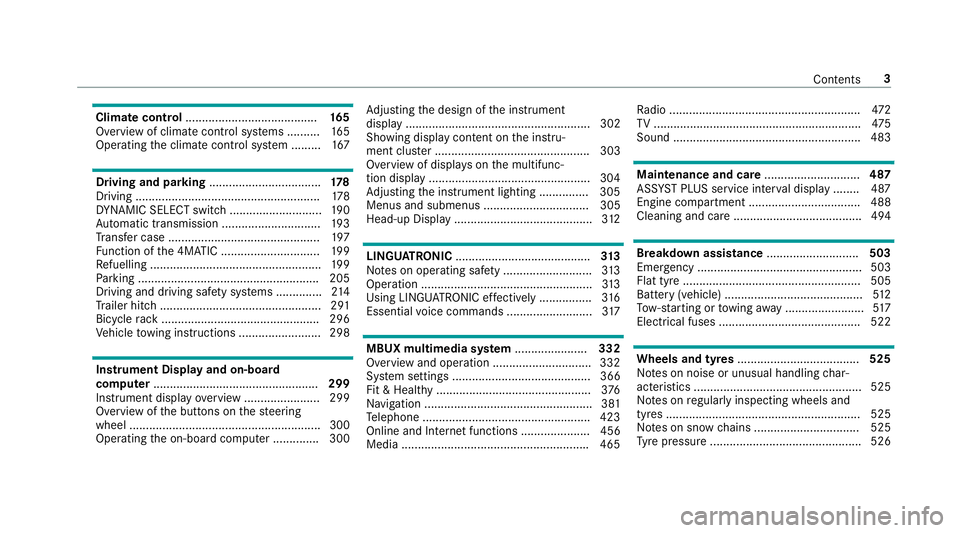
Climate control
........................................ 16 5
Overview of climate contro l systems ..........1 65
Operating the climate control sy stem ......... 167 Driving and pa
rking .................................. 17 8
Driving ........................................................ 178
DY NA MIC SELECT switch ............................1 90
Au tomatic transmission .............................. 19 3
Tr ans fer case .............................................. 197
Fu nction of the 4MATIC .............................. 19 9
Re fuelling .................................................... 19 9
Pa rking ...................................................... .205
Driving and driving saf ety sy stems .............. 214
Tr ailer hit ch................................................. 291
Bicycle rack ................................................ 296
Ve hicle towing instructions ........................ .298 Instrument Display and on-board
comp uter.................................................. 299
Instrument display overview ...................... .299
Overview of the buttons on thesteering
wheel ..........................................................3 00
Operating the on-board computer .............. 300 Ad
justing the design of the instrument
display ........................................................ 302
Showing display conte nt onthe instru‐
ment clus ter ............................................... 303
Overview of displa yson the multifunc‐
tion display .................................................3 04
Ad justing the instrument lighting ............... 305
Menus and submenus ................................ 305
Head-up Display .......................................... 312 LINGU
ATRO NIC ......................................... 313
No tes on operating saf ety .......................... .313
Operation ....................................................3 13
Using LINGU ATRO NIC ef fectively ................ 316
Essential voice commands .......................... 317 MBUX multimedia sy
stem ...................... 332
Overview and operation .............................. 332
Sy stem settings .......................................... 366
Fit & Healt hy............................................... 376
Na vigation ................................................... 381
Te lephone .................................................. .423
Online and Internet functions ..................... 456
Media ........................................................ .465 Ra
dio .......................................................... 472
TV ............................................................... 475
Sound ......................................................... 483 Main
tenance and care ............................. 487
ASS YST PLUS service inter val display ........ 487
Engine compartment .................................. 488
Cleaning and care ...................................... .494 Breakdown assistance
............................503
Emergency .................................................. 503
Flat tyre ...................................................... 505
Battery (vehicle) .......................................... 512
To w- starting or towing away ........................ 517
Electrical fuses ........................................... 522 Wheels and tyres
..................................... 525
No tes on noise or unusual handling char‐
acteristics .................................................. .525
No tes on regularly inspecting wheels and
tyres ........................................................... 525
No tes on snow chains ................................ 525
Ty re pressure .............................................. 526 Contents
3
Page 220 of 681

R
Vehicles with trailer hitch: stabilisation of
th eve hicle/trailer combination is no longer
active.
R Crosswind Assist is no longer active.
R The drive wheels could spin.
R ETS/4ETS traction control is still active.
% When ESP ®
is deactivated, you are still assis‐
te dby ESP ®
when braking.
If th e÷ ESP®
wa rning lamp flashes in the
instrument clus ter,one or se veralve hicle wheels
has reached its grip limit:
R Adapt your driving style to suit the cur rent
ro ad and weather conditions.
R Do not deactivate ESP ®
.
R Onlydepress the accelera tor pedal as far as
is necessar y. Deactivate ESP
®
in thefo llowing situations to
impr ove traction:
R When using snow chains.
R In deep sn ow.
R On sand or gr avel.
% Spinning the wheels results in a cutting
action which pr ovides better grip.
If th e÷ ESP®
wa rning lamp lights up continu‐
ousl y,ESP ®
is not available due toa malfunction.
Obse rveth efo llowing information:
R warning and indicator lamps (→ page616)
R display messa ges (→ page 566)
ETS/4ETS (Electronic Traction Sy stem)
ETS/4E TStraction control is pa rtof ESP ®
and
makes it possible topull away and accelerate on
a slippe rycar riag ewa y. If
yo u select drive program ForG, a spe‐
cial ETS sy stem specifically suited tooff-road
te rrain is automatically activated.
ETS/4E TScan impr oveth eve hicle's traction by
inter vening in thefo llowing ways:
R The drive wheels are braked individually if
they spin.
R More drive torque is transferred tothe wheel
or wheels with traction.
Influence of drive prog rams on ESP ®
The drive programs enable ESP ®
to adapt todif‐
fe re nt we ather and road conditions as well as
th e driver's prefer red driving style. You can
select the drive programs using theDY NA MIC
SELECT switch (→ page191). Driving and parking
217
Page 279 of 681
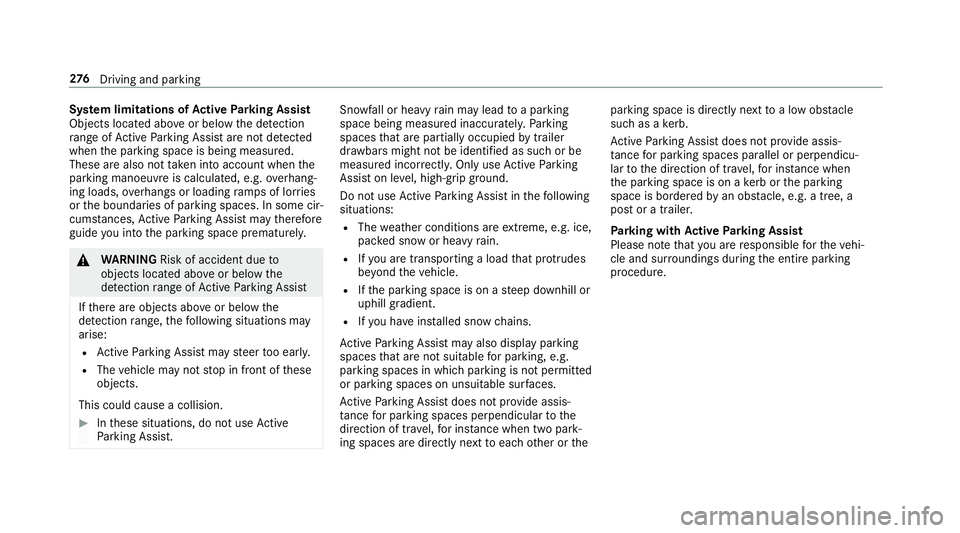
Sy
stem limitations of Active Parking Assist
Objects located abo veor below the de tection
ra nge of Active Parking Assist are not de tected
when the parking space is being measured.
These are also not take n into account when the
parking manoeuvre is calculated, e.g. overhang‐
ing loads, overhangs or loading ramp s of lor ries
or the boundaries of parking spaces. In some cir‐
cums tances, Active Parking Assist may therefore
guide you into the parking space prematurely. &
WARNING Risk of accident due to
objects located abo veor below the
de tection range of Active Parking Assist
If th ere are objects abo veor below the
de tection range, thefo llowing situations may
arise:
R Active Parking Assist may steer too ear ly.
R The vehicle may not stop in front of these
objects.
This could cause a collision. #
Inthese situations, do not use Active
Pa rking Assist. Sn
owfa ll or heavy rain may lead toa parking
space being measured inaccuratel y.Pa rking
spaces that are partial lyoccupied bytrailer
dr aw bars might not be identified as such or be
measured incor rectly. Only use Active Parking
Assist on le vel, high-grip ground.
Do not useActive Parking Assist in thefo llowing
situations:
R The weather conditions are extreme, e.g. ice,
pa cked snow or heavy rain.
R Ifyo u are transpo rting a load that pr otru des
be yond theve hicle.
R Ifth e parking space is on a steep downhill or
uphill gradient.
R Ifyo u ha veinstalled snow chains.
Ac tive Parking Assist may also display parking
spaces that are not suitable for parking, e.g.
parking spaces in which parking is not permitted
or parking spaces on unsuitable sur faces.
Ac tive Parking Assist does not pr ovide assis‐
ta nce for parking spaces perpendicular tothe
direction of tra vel,fo r ins tance when two pa rk‐
ing spaces are direct lynext toeach other or the parking space is directly next
toa low obs tacle
su ch as a kerb.
Ac tive Parking Assist does not pr ovide assis‐
ta nce for parking spaces parallel or perpendicu‐
lar tothe direction of tra vel,fo r ins tance when
th e parking space is on a kerb or the parking
space is bordered byan obs tacle, e.g. a tree, a
post or a traile r.
Pa rking with Active Parking Assist
Please no tethat you are responsible forth eve hi‐
cle and sur roundings during the entire parking
procedure. 276
Driving and pa rking
Page 528 of 681
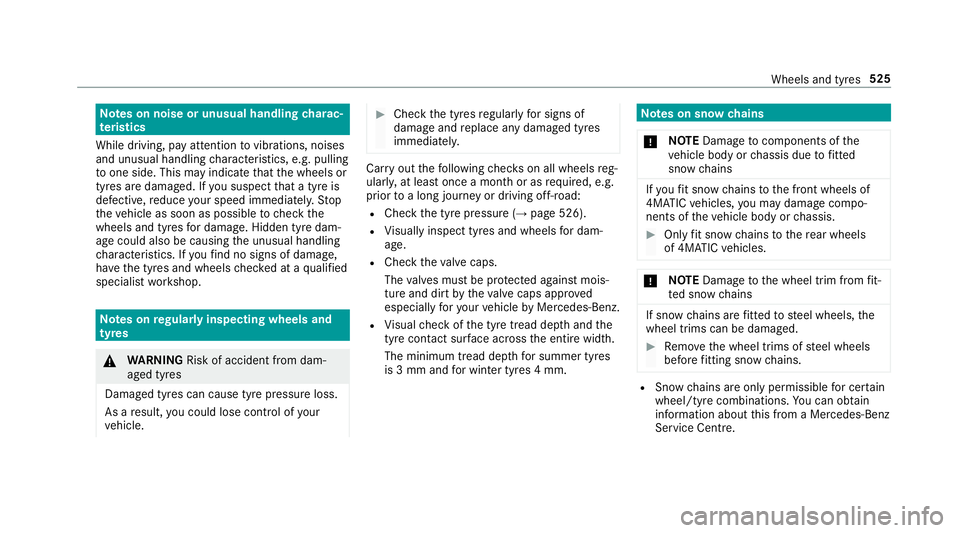
Note
s on noise or unusual handling charac‐
te rist ics
While driving, pay attention tovibrations, noises
and unusual handling characteristics, e.g. pulling
to one side. This may indicate that the wheels or
tyres are damaged. If you suspect that a tyre is
defective, reduce your speed immediatel y.Stop
th eve hicle as soon as possible tocheck the
wheels and tyres for dama ge. Hidden tyre dam‐
age could also be causing the unusual handling
ch aracteristics. If youfind no signs of damage,
ha ve the tyres and wheels checked at a qualified
specialist workshop. Note
s onregular lyinspecting wheels and
tyres &
WARNING Risk of accident from dam‐
aged tyres
Dama ged tyres can cause tyre pressure loss.
As a result, you could lose cont rol of your
ve hicle. #
Check the tyres regularly for signs of
dama geand replace any damaged tyres
immediatel y. Car
ryout thefo llowing checks on all wheels reg‐
ularly, at least once a month or as requ ired, e.g.
prior toa long journey or driving off- road:
R Check the tyre pressure (→ page 526).
R Visually inspect tyres and wheels for dam‐
age.
R Check theva lve caps.
The valves must be pr otected against mois‐
ture and dirt bytheva lve caps appr oved
especially foryo ur vehicle byMercedes-Benz.
R Visual check of the tyre tread dep thand the
tyre contact su rface across the entire width.
The minimum tread dep thfor summer tyres
is 3 mm and for winter tyres 4 mm. Note
s on snow chains
* NO
TEDama getocomponents of the
ve hicle body or chassis due tofitted
snow chains If
yo ufit snow chains tothe front wheels of
4MATIC vehicles, you may damage co mpo‐
nents of theve hicle body or chassis. #
Onlyfit snow chains tothere ar wheels
of 4MATIC vehicles. *
NO
TEDama getothe wheel trim from fit‐
te d snow chains If sn
ow ch ains are fitted tosteel wheels, the
wheel trims can be damaged. #
Remo vethe wheel trims of steel wheels
before fitting snow chains. R
Snow chains are on ly permissible for cer tain
wheel/tyre combinations. You can obtain
information about this from a Mercedes-Benz
Service Cent re. Wheels and tyres
525
Page 529 of 681
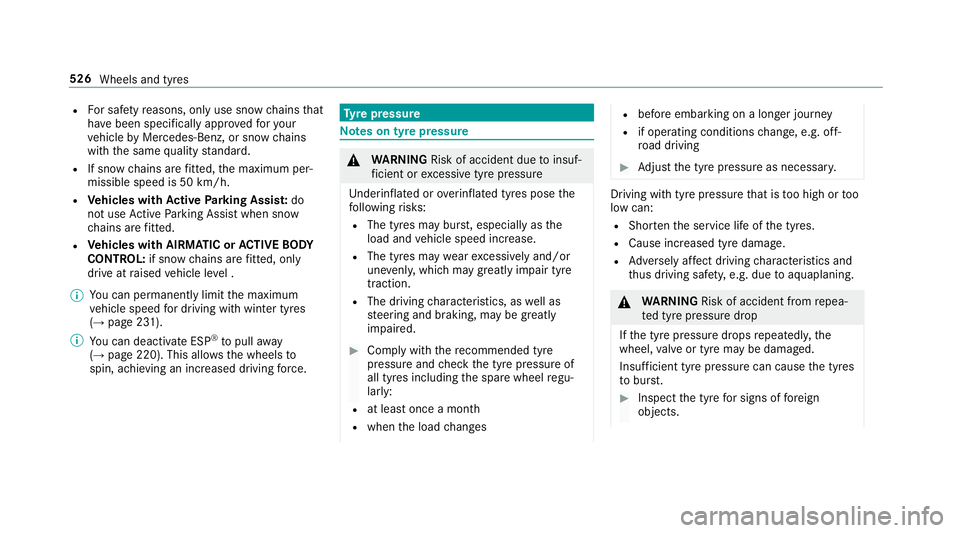
R
For saf etyre asons, on lyuse sn ow chainsthat
ha ve been specifically appr oved foryo ur
ve hicle byMercedes-Benz, or snow chains
with the same quality standard.
R If sn ow ch ains are fitted, the maximum per‐
missible speed is 50 km/h.
R Vehicles with Active Parking Assis t:do
not use Active Parking Assist when snow
ch ains are fitted.
R Vehicles with AIRMATIC or ACTIVE BODY
CONT ROL:if snow chains are fitted, only
drive at raised vehicle le vel .
% You can permanently limit the maximum
ve hicle speed for driving with winter tyres
(→ page 231).
% You can deactivate ESP ®
to pull away
( → page 220). This allo wsthe wheels to
spin, achieving an increased driving forc e. Ty
re pressure Note
s on tyre pressure &
WARNING Risk of accident due toinsuf‐
fi cient or excessive tyre pressure
Underinfla ted or overinfla ted tyres pose the
fo llowing risks:
R The tyres may bur st, especially as the
load and vehicle speed increase.
R The tyres may wearexc essively and/or
une venly, which may greatlyimpair tyre
traction.
R The driving characteristics, as well as
st eering and braking, may be greatly
impaired. #
Comply with there commended tyre
pressure and check the tyre pressure of
all tyres including the spare wheel regu‐
larly:
R at least once a month
R when the load changes R
before embarking on a lon ger journey
R if operating conditions change, e.g. off-
ro ad driving #
Adjust the tyre pressure as necessar y. Driving wi
thtyre pressu rethat is too high or too
low can:
R Sho rten the service life of the tyres.
R Cause increased tyre damage.
R Adversely af fect driving characteristics and
th us driving saf ety, e.g. due toaquaplaning. &
WARNING Risk of accident from repea‐
te d tyre pressure drop
If th e tyre pressure drops repeatedl y,the
wheel, valve or tyre may be damaged.
Insuf ficient tyre pressure can cause the tyres
to bur st. #
Inspect the tyre for signs of fore ign
objects. 526
Wheels and tyres
Page 537 of 681
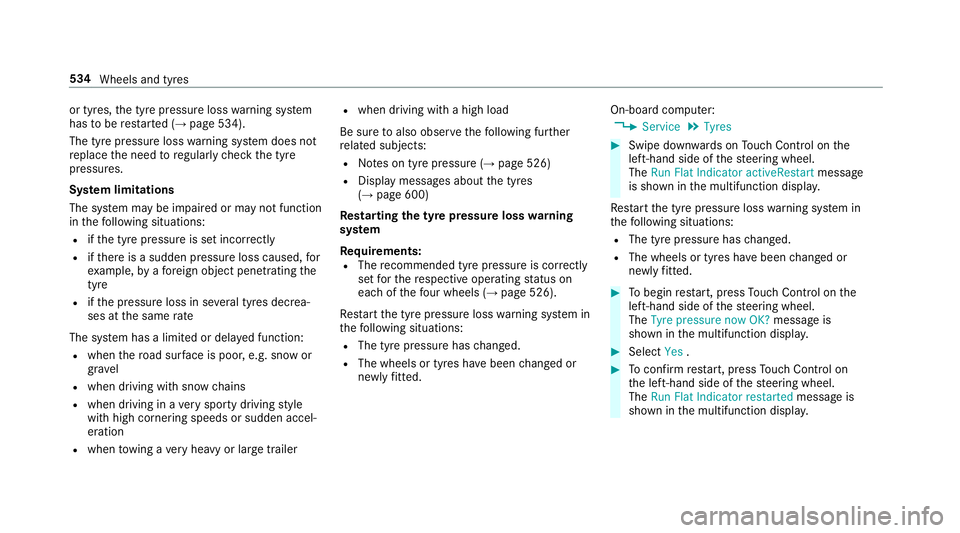
or tyres,
the tyre pressure loss warning sy stem
has tobe restar ted (→ page 534).
The tyre pressure loss warning sy stem does not
re place the need toregular lych eck the tyre
pressures.
Sy stem limitations
The sy stem may be impaired or may not function
in thefo llowing situations:
R ifth e tyre pressure is set incor rectly
R ifth ere is a sudden pressure loss caused, for
ex ample, byafo re ign object penetrating the
tyre
R ifth e pressure loss in se veral tyres decrea‐
ses at the same rate
The sy stem has a limited or dela yed function:
R when thero ad sur face is poo r,e.g. snow or
gra vel
R when driving with sn ow chains
R when driving in a very sporty driving style
with high cornering speeds or sudden accel‐
eration
R when towing a very heavy or large trailer R
when driving with a high load
Be sure toalso obse rveth efo llowing fur ther
re lated subjects:
R Notes on tyre pressure (→ page 526)
R Display messages about the tyres
(→ page 600)
Re starting the ty repressure loss warning
sy stem
Requ irements:
R The recommended tyre pressure is cor rectly
set forth ere spective operating status on
each of thefo ur wheels (→ page 526).
Re start the tyre pressure loss warning sy stem in
th efo llowing situations:
R The tyre pressure has changed.
R The wheels or tyres ha vebeen changed or
newly fitted. On-boa
rdcompu ter:
, Service .
Tyres #
Swipe down wards on Touch Control on the
left-hand side of thesteering wheel.
The Run Flat Indicator activeRestart message
is shown in the multifunction displa y.
Re start the tyre pressure loss warning sy stem in
th efo llowing situations:
R The tyre pressure has changed.
R The wheels or tyres ha vebeen changed or
newly fitted. #
Tobegin restart, press Touch Control on the
left-hand side of thesteering wheel.
The Tyre pressure now OK? message is
shown in the multifunction displa y. #
Select Yes. #
Toconfirm restart, press Touch Control on
th e left-hand side of thesteering wheel.
The Run Flat Indicator restarted message is
shown in the multifunction displa y.534
Wheels and tyres
Page 548 of 681
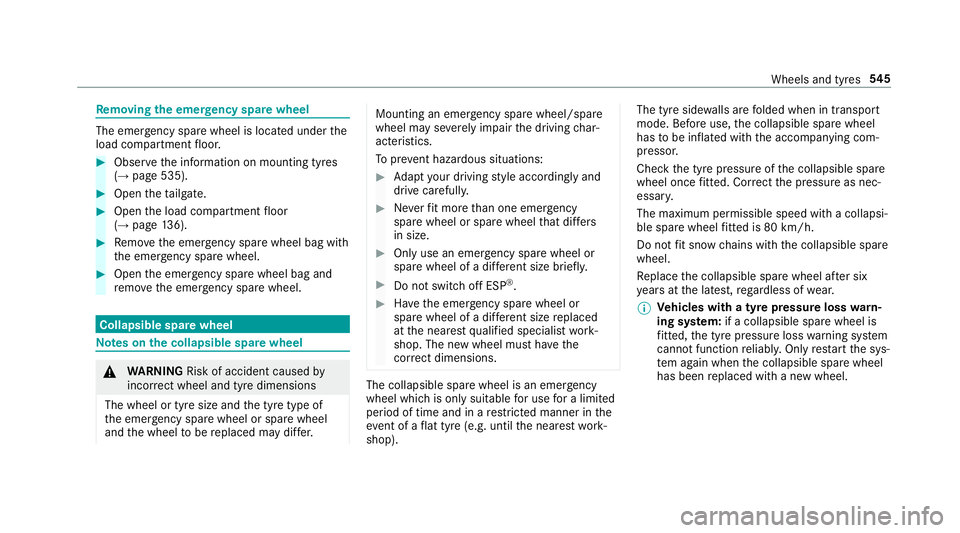
Re
moving the eme rgency spa rewheel The eme
rgency spare wheel is located under the
load compartment floor. #
Obser vethe information on mounting tyres
(→ page 535). #
Open theta ilgate. #
Open the load compartment floor
(→ page 136). #
Remo vethe emer gency spa rewheel bag with
th e emer gency spa rewheel. #
Open the emer gency spa rewheel bag and
re mo vethe emer gency spa rewheel. Collapsible spa
rewheel Note
s onthe collapsible spa rewheel &
WARNING Risk of accident caused by
incor rect wheel and tyre dimensions
The wheel or tyre size and the tyre type of
th e emer gency spa rewheel or spare wheel
and the wheel tobe replaced may dif fer. Mounting an emer
gency spa rewheel/spare
wheel may se verely impair the driving char‐
acteristics.
To preve nt hazardous situations: #
Adapt your driving style according lyand
drive carefull y. #
Neverfit more than one emer gency
spa rewheel or spare wheel that dif fers
in size. #
Only use an emer gency spa rewheel or
spare wheel of a dif fere nt size brie fly. #
Do not switch off ESP ®
. #
Have the emer gency spa rewheel or
spare wheel of a dif fere nt size replaced
at the nearest qualified specialist work‐
shop. The new wheel must ha vethe
cor rect dimensions. The collapsible spa
rewheel is an emer gency
wheel which is only suitable for use for a limi ted
period of time and in a restricted manner in the
eve nt of a flat tyre (e.g. until the nearest work‐
shop). The tyre side
walls are folded when in transpo rt
mode. Before use, the collapsible spare wheel
has tobe inflated with the accompanying com‐
pressor.
Check the tyre pressure of the collapsible spare
wheel once fitted. Co rrect the pressure as nec‐
essar y.
The maximum permissible speed with a collapsi‐
ble spare wheel fitted is 80 km/h.
Do not fit snow chains with the collapsible spare
wheel.
Re place the collapsible spare wheel af ter six
ye ars at the latest, rega rdless of wear.
% Ve
hicles with a tyre pressure loss warn‐
ing sy stem: if a collapsible spare wheel is
fi tted, the tyre pressure loss warning sy stem
cann otfunction reliabl y.Only restart the sys‐
te m again when the collapsible spare wheel
has been replaced with a new wheel. Wheels and tyres
545
Page 666 of 681
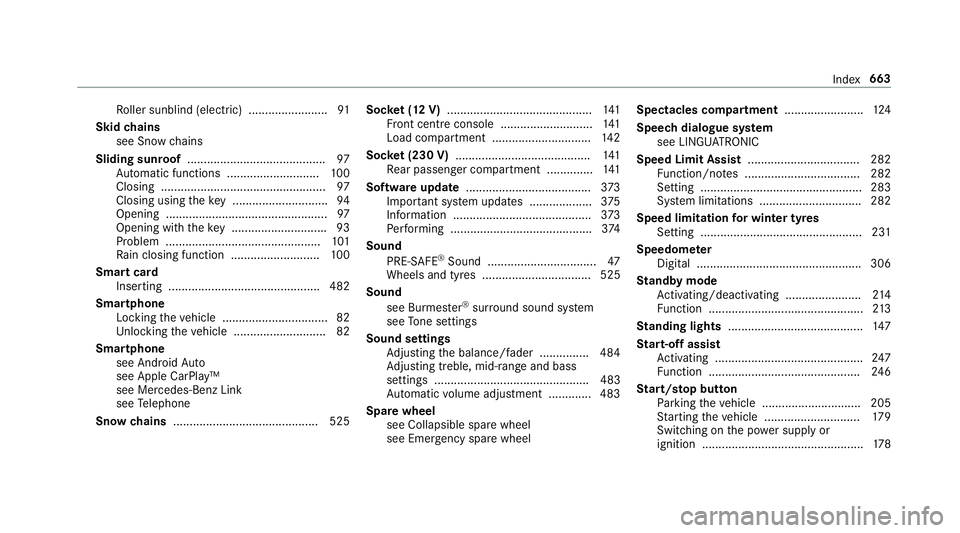
Ro
ller sunblind (elect ric) ........................ 91
Skid chains
see Snow chains
Sliding sun roof .......................................... 97
Au tomatic functions ............................ 100
Closing .................................................. 97
Closing using theke y ............................ .94
Opening .................................................97
Opening with theke y ............................ .93
Problem ............................................... 101
Ra in closing function .......................... .100
Smart card Inserting .............................................. 482
Smartphone Locking theve hicle ................................ 82
Un locking theve hicle ............................82
Smartphone see Android Auto
see Apple CarPlay™
see Mercedes-Benz Link
see Telephone
Snow chains ............................................ 525 Soc
ket (12 V) ............................................ 141
Fr ont centre console ............................ 141
Load compartment .............................. 14 2
Soc ket (230 V) ......................................... 141
Re ar passenger compartment .............. 141
Software update ...................................... 373
Impor tant sy stem updates ...................3 75
Information .......................................... 373
Pe rforming ...........................................3 74
Sound PRE-SAFE ®
Sound ................................. 47
Wheels and tyres ................................. 525
Sound see Burmes ter®
sur round sound sy stem
see Tone settings
Sound settings Adjusting the balance/fader ............... 484
Ad justing treble, mid-range and bass
settings ............................................... 483
Au tomatic volume adjustment ............ .483
Spare wheel see Collapsible spa rewheel
see Emer gency spa rewheel Spectacles compa
rtment ........................ 124
Speech dialogue sy stem
see LINGU ATRO NIC
Speed Limit Assist .................................. 282
Fu nction/no tes ................................... 282
Setting .................................................2 83
Sy stem limitations ...............................2 82
Speed limitation for winter tyres
Setting ................................................. 231
Speedome ter
Digital ................................................. .306
St andby mode
Ac tivating/deactivating ...................... .214
Fu nction ............................................... 213
St anding lights ......................................... 147
St art-off assi st
Ac tivating ............................................ .247
Fu nction .............................................. 24 6
St art/s top button
Pa rking theve hicle .............................. 205
St arting theve hicle ............................. 17 9
Switching on the po wer supply or
ignition ................................................. 178 Index
663